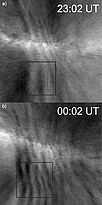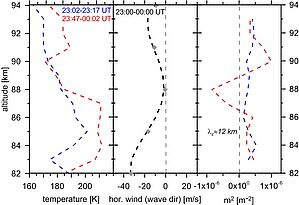Gravity wave signatures in OH airglow
Some trace gases in the mesopause region are emitting light due to chemical production. This light is named airglow and can be observed during the night. Important airglow trace gases are hydroxyl (OH, mean emission altitude 87 km), molecular oxygen (O2, 94 km), and atomic oxygen (O(I), 96 km). Each airglow layer is several kilometers thick. Gravity waves modulate altitudes and temperatures of these layers, influencing the brightness of the emission. Camera observations of the airglow reveal horizontal wavelengths and periods of gravity waves. Combination of these data with vertical profiles of temperatures and winds (e.g., from lidars and radars) provide quasi 3-d observations of waves and, by this, additional information for the understanding von gravity wave propagation.
The images in the example show the OH layer above Kühlungsborn with one hour separation. The horizontal wavelength in the later image is only half of the first. Simultaneous lidar observations show a temperature increase between 82 and 88 km altitude. Including also wind data, the vertical wavenumber m (the inverse of the vertical wavelength) can be calculated. During the second image we found m2 < 0, i.e., the wave could not propagate and the energy needed to be dissipated. This is observed by the shortening of horizontal wavelength. Here, lidar and radar data explain the observations of the airglow camera.
IAP is not operating own airglow cameras. 2007 a camera system of Utah State University (PI: Prof. Michael Taylor) was installed at Kühlungsborn. In September 2010 and since March 2012 a camera of NIPR/Nagoya University (PI: Prof. Shin Suzuki, Prof. Takuchi Nakamura) is installed at IAP. Also our lidar sites Andenes/Norway and Davis/Antarctica are equipped with airglow imagers.














